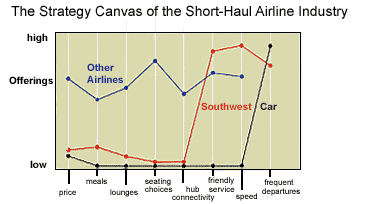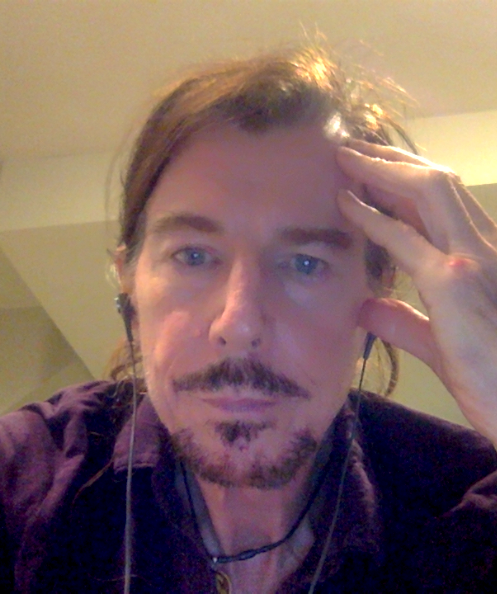 Last week I wrote about disruptive innovation as described in Clay Christensen’s book The Innovator’s Solution, and lamented that, although Christensen provides a variety of tools and techniques for innovation his methodology lacks an approach to the lateral thinking or ‘imagineering’ that is needed to apply them effectively. Now, Nicholas Carr, author of the provocative 2003 HBR article “IT Doesn’t Matter” (which I reviewed here) and a subsequent book on the same subject called Does IT Matter?, has written a supplement to Christensen’s work in Strategy + Business magazine, describing a fourth type of innovation he calls “Top-Down Disruption”. Here’s a synopsis of all four types:
The first and fourth types are used primarily by incumbents, market leaders in an industry, while the second and third types can be used by new entrants to gain a foothold in an industry. Top-Down Disruptive Innovations, Carr argues, can exploit the same long-term trend to more powerful technologies and falling commodity prices that low-end disrupters use, except that instead of cannibalizing the market from the bottom-up (as increasing power/cost allows the lowly disruption to do successively more and more for the same price), it cannibalizes the market from the top-down (as increasing power/cost allows it to reduce prices from premium to mainstream and make the product affordable and valuable to all its customers). There is some danger in doing this, of course, since you may be obsolescing some of your own company’s products, but since you’re in the driver’s seat (with a market lead in the new product, and a strong relationship with existing customers) and since you’re also cannibalizing competitors’ products at the same time, the risk is usually worth it. Carr argues that the iPod is also a top-down disruption, but I’m not so sure. Carr himself admits that the iPod, offering more (capacity and features) for more (money), was not initially a market success. I’m I’m sitting here beside my Creative Nomad, which is admittedly larger but still portable and which beat the iPod into the market by at least a couple of years with essentially the same capacity and functionality. And one of the most popular iPods is the mini, which actually doesn’t offer a disruptive innovation at all (its capacity is quite modest compared to competitive offerings). No doubt there were other factors (style, the value of the Apple brand, marketing resources, timing) which account for the iPod mini’s success and the Nomad’s (relative) failure. But much more study is needed to discover why some top-down disruptions succeed while others fail. Christensen argues that it is very dangerous for new entrants to try to introduce innovations that can be co-opted by incumbents as sustaining innovations, and I think there is an argument that the iPod was Apple’s sustaining innovation for its established customers in response to the attempted disruptive innovations of Creative and other early entrants into hard-drive based portable music players. In fact, Carr argues that because of their adaptability and lack of investment in existing products, new entrants are at a competitive advantage compared to incumbents in introducing top-down disruptive innovations. I don’t think this is true. Many brave entrepreneurs, for example, like Bricklin, have tried introducing premium automobiles for high-income car-lovers, but almost none of them have survived. They play right into the hands of mainstream premium automakers, doing their market research for them, so that these incumbents can build the attributes that customers liked into their next offerings. Carr is right on identifying this as a fourth innovation category, but I think it’s strictly an incumbents’ game, especially if the incumbent does what Christensen suggests, and have the top-down disruptions developed by a separate, autonomous division. I’ve described before the ten ways in which you can innovate, using the Doblin Group taxonomy:
So if you map these ten ways of innovating (and add additional factors that Doblin doesn’t consider terribly innovative, like Price and Speed of Service) against the four Christensen-Carr types of innovation you have a 4 x 12 matrix of innovation opportunities. Then you can layer on the Strategy Canvas described in Kim & Mauborgne’s Blue Ocean Strategy, which chart the value that customers place on attributes of the products and services your industry provides (or might provide through disruptive innovation). An example from their book is reproduced above, showing that Southwest Airlines innovated by differentiating itself from other airlines in three ways (friendly service, speed and frequent departures) that customers really valued, and not attempting to compete on price, meals, lounge service or other attributes that customers cared less about. Combining these three sources provides the basis for a comprehensive and intriguing methodology for innovation:
Tomorrow I’ll present a ‘straw man’ case walking through this methodology (with the benefit of hindsight) as it might have applied in the transformation, a generation ago, of a troubled company into an innovation leader. |
Navigation
Collapsniks
Albert Bates (US)
Andrew Nikiforuk (CA)
Brutus (US)
Carolyn Baker (US)*
Catherine Ingram (US)
Chris Hedges (US)
Dahr Jamail (US)
Dean Spillane-Walker (US)*
Derrick Jensen (US)
Dougald & Paul (IE/SE)*
Erik Michaels (US)
Gail Tverberg (US)
Guy McPherson (US)
Honest Sorcerer
Janaia & Robin (US)*
Jem Bendell (UK)
Mari Werner
Michael Dowd (US)*
Nate Hagens (US)
Paul Heft (US)*
Post Carbon Inst. (US)
Resilience (US)
Richard Heinberg (US)
Robert Jensen (US)
Roy Scranton (US)
Sam Mitchell (US)
Tim Morgan (UK)
Tim Watkins (UK)
Umair Haque (UK)
William Rees (CA)
XrayMike (AU)
Radical Non-Duality
Tony Parsons
Jim Newman
Tim Cliss
Andreas Müller
Kenneth Madden
Emerson Lim
Nancy Neithercut
Rosemarijn Roes
Frank McCaughey
Clare Cherikoff
Ere Parek, Izzy Cloke, Zabi AmaniEssential Reading
Archive by Category
My Bio, Contact Info, Signature Posts
About the Author (2023)
My Circles
E-mail me
--- My Best 200 Posts, 2003-22 by category, from newest to oldest ---
Collapse Watch:
Hope — On the Balance of Probabilities
The Caste War for the Dregs
Recuperation, Accommodation, Resilience
How Do We Teach the Critical Skills
Collapse Not Apocalypse
Effective Activism
'Making Sense of the World' Reading List
Notes From the Rising Dark
What is Exponential Decay
Collapse: Slowly Then Suddenly
Slouching Towards Bethlehem
Making Sense of Who We Are
What Would Net-Zero Emissions Look Like?
Post Collapse with Michael Dowd (video)
Why Economic Collapse Will Precede Climate Collapse
Being Adaptable: A Reminder List
A Culture of Fear
What Will It Take?
A Future Without Us
Dean Walker Interview (video)
The Mushroom at the End of the World
What Would It Take To Live Sustainably?
The New Political Map (Poster)
Beyond Belief
Complexity and Collapse
Requiem for a Species
Civilization Disease
What a Desolated Earth Looks Like
If We Had a Better Story...
Giving Up on Environmentalism
The Hard Part is Finding People Who Care
Going Vegan
The Dark & Gathering Sameness of the World
The End of Philosophy
A Short History of Progress
The Boiling Frog
Our Culture / Ourselves:
A CoVid-19 Recap
What It Means to be Human
A Culture Built on Wrong Models
Understanding Conservatives
Our Unique Capacity for Hatred
Not Meant to Govern Each Other
The Humanist Trap
Credulous
Amazing What People Get Used To
My Reluctant Misanthropy
The Dawn of Everything
Species Shame
Why Misinformation Doesn't Work
The Lab-Leak Hypothesis
The Right to Die
CoVid-19: Go for Zero
Pollard's Laws
On Caste
The Process of Self-Organization
The Tragic Spread of Misinformation
A Better Way to Work
The Needs of the Moment
Ask Yourself This
What to Believe Now?
Rogue Primate
Conversation & Silence
The Language of Our Eyes
True Story
May I Ask a Question?
Cultural Acedia: When We Can No Longer Care
Useless Advice
Several Short Sentences About Learning
Why I Don't Want to Hear Your Story
A Harvest of Myths
The Qualities of a Great Story
The Trouble With Stories
A Model of Identity & Community
Not Ready to Do What's Needed
A Culture of Dependence
So What's Next
Ten Things to Do When You're Feeling Hopeless
No Use to the World Broken
Living in Another World
Does Language Restrict What We Can Think?
The Value of Conversation Manifesto Nobody Knows Anything
If I Only Had 37 Days
The Only Life We Know
A Long Way Down
No Noble Savages
Figments of Reality
Too Far Ahead
Learning From Nature
The Rogue Animal
How the World Really Works:
Making Sense of Scents
An Age of Wonder
The Truth About Ukraine
Navigating Complexity
The Supply Chain Problem
The Promise of Dialogue
Too Dumb to Take Care of Ourselves
Extinction Capitalism
Homeless
Republicans Slide Into Fascism
All the Things I Was Wrong About
Several Short Sentences About Sharks
How Change Happens
What's the Best Possible Outcome?
The Perpetual Growth Machine
We Make Zero
How Long We've Been Around (graphic)
If You Wanted to Sabotage the Elections
Collective Intelligence & Complexity
Ten Things I Wish I'd Learned Earlier
The Problem With Systems
Against Hope (Video)
The Admission of Necessary Ignorance
Several Short Sentences About Jellyfish
Loren Eiseley, in Verse
A Synopsis of 'Finding the Sweet Spot'
Learning from Indigenous Cultures
The Gift Economy
The Job of the Media
The Wal-Mart Dilemma
The Illusion of the Separate Self, and Free Will:
No Free Will, No Freedom
The Other Side of 'No Me'
This Body Takes Me For a Walk
The Only One Who Really Knew Me
No Free Will — Fightin' Words
The Paradox of the Self
A Radical Non-Duality FAQ
What We Think We Know
Bark Bark Bark Bark Bark Bark Bark
Healing From Ourselves
The Entanglement Hypothesis
Nothing Needs to Happen
Nothing to Say About This
What I Wanted to Believe
A Continuous Reassemblage of Meaning
No Choice But to Misbehave
What's Apparently Happening
A Different Kind of Animal
Happy Now?
This Creature
Did Early Humans Have Selves?
Nothing On Offer Here
Even Simpler and More Hopeless Than That
Glimpses
How Our Bodies Sense the World
Fragments
What Happens in Vagus
We Have No Choice
Never Comfortable in the Skin of Self
Letting Go of the Story of Me
All There Is, Is This
A Theory of No Mind
Creative Works:
Mindful Wanderings (Reflections) (Archive)
A Prayer to No One
Frogs' Hollow (Short Story)
We Do What We Do (Poem)
Negative Assertions (Poem)
Reminder (Short Story)
A Canadian Sorry (Satire)
Under No Illusions (Short Story)
The Ever-Stranger (Poem)
The Fortune Teller (Short Story)
Non-Duality Dude (Play)
Your Self: An Owner's Manual (Satire)
All the Things I Thought I Knew (Short Story)
On the Shoulders of Giants (Short Story)
Improv (Poem)
Calling the Cage Freedom (Short Story)
Rune (Poem)
Only This (Poem)
The Other Extinction (Short Story)
Invisible (Poem)
Disruption (Short Story)
A Thought-Less Experiment (Poem)
Speaking Grosbeak (Short Story)
The Only Way There (Short Story)
The Wild Man (Short Story)
Flywheel (Short Story)
The Opposite of Presence (Satire)
How to Make Love Last (Poem)
The Horses' Bodies (Poem)
Enough (Lament)
Distracted (Short Story)
Worse, Still (Poem)
Conjurer (Satire)
A Conversation (Short Story)
Farewell to Albion (Poem)
My Other Sites





Great article! The Doblin Group taxonomy looks like a business plan to me. It should help everyone to come up with a business idea, a technology, a product, a service. Apart from two specific issues: (1) Enabling process; (2) Customer experience. It’s rare enough to mention it, especially when it’s linked to user-centered innovation. When we think of supporting company’s processes and workers, we mean caring about employees’ health and security, optimizing the work environment and overall logistics, supporting ethic management, implementing environmental friendly production processes and offering awaited products or services. It goes along with the REPUTATION of the company; it has nothing to do with trademark or any other kind of marketing-oriented image creation. It simply meets customers’ real needs, while first being concerned with those who take care of the job and their environment. This is the realm of occupational medicine, occupational hygiene, ergonomics, work psychology, logistics, corporate governance and political economics. Future innovative boosters will CRASH the value/cost trade-off and create THE uncontested market space we all dream off: the VALUE FOR LIFE trade-off!!! Create and capture new demand by offering priceless products and services, at low cost, those that really increase the quality of political debate, the quality of education and the quality of life. Create stuff that helps people to build a freedom-based society, the one that gets rid of human starvation, offers fun & comfort and respect Gaia. We shall change the rules, expand imagination beyond metaphysics and assume being pataphysicians once for all. Science shall be there to serve humans, not the other way round. All the rest is bullshit:http://www.ralphmag.org/jarry.html
Hi Dave,Nice write up on this info.I have read the Blue Ocean Stratey but are having trouble plotting out a strategy canvas. I cant seem to work out what competiting factors for a IT distributor could put.Should I be using this as per product category instead? It’s got me very confused!I’ve been trying to get my business back on track for 5 years now and have been struggling. (two man operation)I’d appreciate your help! Thanks.